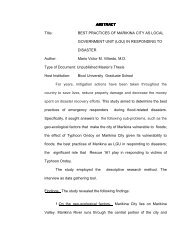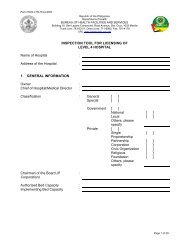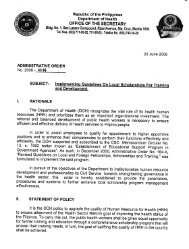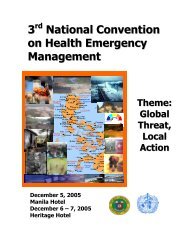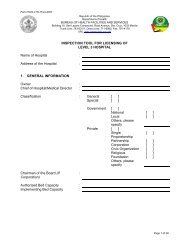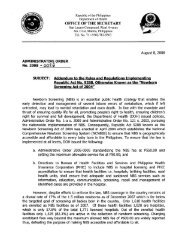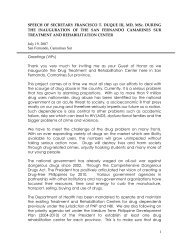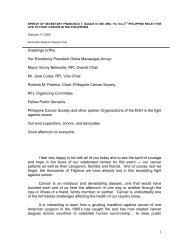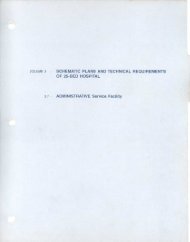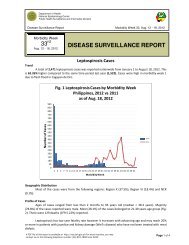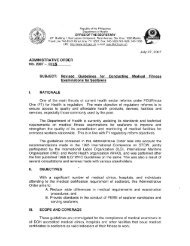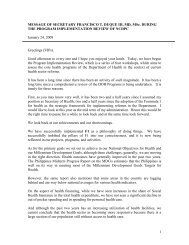Issue No. 67 - November to December 2011 - DOH
Issue No. 67 - November to December 2011 - DOH
Issue No. 67 - November to December 2011 - DOH
- No tags were found...
Create successful ePaper yourself
Turn your PDF publications into a flip-book with our unique Google optimized e-Paper software.
swell.Sometimes, the testicles stayinside the lower abdominal tract or whatis called undescended testes. Surgery cancorrect and put the testicles in the scrotum.Like the ovaries of the female,testicles are components of both thereproductive system (being gonads) and theendocrine system (being endocrine glands).The respective functions of the testiclesare: producing sperm (sperma<strong>to</strong>zoa) andproducing male sex hormones, of whichtes<strong>to</strong>sterone is the best-known.The testicles are well-known <strong>to</strong>be very sensitive <strong>to</strong> impact and injury. Blueballs is a slang term for a temporary fluidcongestion in the testicles and prostateregion caused by prolonged sexual arousal.The most prominent diseases oftesticles are: testicular cancer and otherneoplasms; swelling of a testicle, causedby hydrocele testis; inflammation of thetesticles, called orchitis; inflammation of theepididymis, called epididymitis;spermatic cord <strong>to</strong>rsion alsocalled testicular <strong>to</strong>rsion;varicocele or swollen vein fromthe testes, usually affecting theleft testicle; and anorchidismis the absence of one or bothtesticles.The removal of oneor both testicles is termed asorchidec<strong>to</strong>my, in medicineand castration in generaluse, especially when done aspunishment or <strong>to</strong>rture, or as acatch-all term for orchidec<strong>to</strong>myin a veterinary context. On theother hand, it is called geldingspecifically in the equine sense.Know Your Own BallsBecome familiar with16 HEALTHbeat I <strong>No</strong>vember - <strong>December</strong> <strong>2011</strong>the look, feel and shape of your own testiclesbecause this will help you notice just in caseanything goes wrong.Let’s do a recap. The characteristicsof healthy testicles include:• each testicle feels like a smooth,firm egg;• one testicle tends <strong>to</strong> hang lowerthan the other;• one testicle may be slightly largerthan the other;• there is no pain or discomfortwhen the testicles and scrotum arehandled gently; and• the testicles and scrotum will bepulled up close <strong>to</strong> your body whenthey are cold. They will be hangingdown loose when hot. This is handledau<strong>to</strong>matically <strong>to</strong> keep the testicles atthe right temperature.Once a month, check each testicleby gently rolling it between your thumb andone or two fingers. Perform this check afterOrchidometer - used <strong>to</strong> measure testicle size and track sexual developmentin boys.a warm shower or bath when the scrotumskin is soft and the testicles are down furtherfrom the body. You need <strong>to</strong> get <strong>to</strong> know whatyour testicles feel like and what is normal foryou.Look for lumps (usually on the fron<strong>to</strong>r side of the testicle), swelling, discomfort,change in size and shape (other than normalteenage growth of the testicles), a sensationof heaviness in the testicles. If you have aproblem, it is important <strong>to</strong> realize that youmay have only some of the symp<strong>to</strong>ms listedhere and not all of them.In case of injury, you canunderstand what it feels like <strong>to</strong> have thetesticles hit by something - even lightly. Thepain and discomfort is beyond words andgoes right up through the whole body. If thepain does not go away after a reasonableperiod of time or new lumps or swellingappears, have your balls checked by a doc<strong>to</strong>r.Immediately swallow your prideand get medical advice. A doc<strong>to</strong>r willexamine your testicles andadvise you if there is a problem.If testicular cancer is detectedearly in its development, thenthe cure rate is almost 100%.If there is a problem, the longeryou put off going <strong>to</strong> the doc<strong>to</strong>r,the less chance of <strong>to</strong>tal recovery.The lifetime risk of amale developing testicularcancer is 1 in 316. It is the mostcommon cancer experiencedby men, 15-35 years old. Thoseoutside this age group canstill develop this cancer, theonly difference is that it is notthe most common cancer forthat age range. The cause oftesticular cancer is unknown,but the rate of having thiscancer is rising.- o O o -




